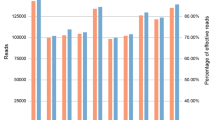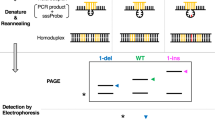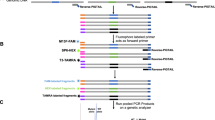Abstract
We report on the development of molecular inversion probe (MIP) genotyping, an efficient technology for large-scale single nucleotide polymorphism (SNP) analysis. This technique uses MIPs to produce inverted sequences, which undergo a unimolecular rearrangement and are then amplified by PCR using common primers and analyzed using universal sequence tag DNA microarrays, resulting in highly specific genotyping. With this technology, multiplex analysis of more than 1,000 probes in a single tube can be done using standard laboratory equipment. Genotypes are generated with a high call rate (95%) and high accuracy (>99%) as determined by independent sequencing.
This is a preview of subscription content, access via your institution
Access options
Subscribe to this journal
Receive 12 print issues and online access
$209.00 per year
only $17.42 per issue
Buy this article
- Purchase on Springer Link
- Instant access to full article PDF
Prices may be subject to local taxes which are calculated during checkout




Similar content being viewed by others
References
Patil, N. et al. Blocks of limited haplotype diversity revealed by high-resolution scanning of human chromosome 21. Science 294, 1719–1723 (2001).
Syvanen, A.C. Accessing genetic variation: genotyping single nucleotide polymorphisms. Nat. Rev. Genet. 2, 930–942 (2001).
Nilsson, M. et al. Making ends meet in genetic analysis using padlock probes. Hum. Mutat. 19, 410–415 (2002).
Elnifro, E.M., Ashshi, A.M., Cooper, R.J. & Klapper, P.E. Multiplex PCR: optimization and application in diagnostic virology. Clin. Microbiol. Rev. 13, 559–570 (2000).
Lockhart, D.J. et al. Expression monitoring by hybridization to high-density oligonucleotide arrays. Nat. Biotechnol. 14, 1675–1680 (1996).
Schena, M., Shalon, D., Davis, R.W. & Brown, P.O. Quantitative monitoring of gene expression patterns with a complementary DNA microarray. Science 270, 467–470 (1995).
Lyamichev, V. et al. Polymorphism identification and quantitative detection of genomic DNA by invasive cleavage of oligonucleotide probes. Nat. Biotechnol. 17, 292–296 (1999).
Eis, P.S. et al. An invasive cleavage assay for direct quantitation of specific RNAs. Nat. Biotechnol. 19, 673–676 (2001).
Nilsson, M. et al. Padlock probes: circularizing oligonucleotides for localized DNA detection. Science 265, 2085–2088 (1994).
Lizardi, P.M. et al. Mutation detection and single-molecule counting using isothermal rolling-circle amplification. Nat. Genet. 19, 225–232 (1998).
Faruqi, A.F. et al. High-throughput genotyping of single nucleotide polymorphisms with rolling circle amplification. BMC Genomics 2, 4 (2001).
Antson, D.O., Isaksson, A., Landegren, U. & Nilsson, M. PCR-generated padlock probes detect single nucleotide variation in genomic DNA. Nucleic Acids Res. 28, E58 (2000).
Shoemaker, D.D., Lashkari, D.A., Morris, D., Mittmann, M. & Davis, R.W. Quantitative phenotypic analysis of yeast deletion mutants using a highly parallel molecular bar-coding strategy. Nat. Genet. 14, 450–456 (1996).
Zhang, D.Y., Brandwein, M., Hsuih, T.C. & Li, H. Amplification of target-specific, ligation-dependent circular probe. Gene 211, 277–285 (1998).
Abravaya, K., Carrino, J.J., Muldoon, S. & Lee, H.H. Detection of point mutations with a modified ligase chain reaction (Gap-LCR). Nucleic Acids Res. 23, 675–682 (1995).
Banér, J., Nilsson, M., Mendel-Hartvig, M. & Landegren, U. Signal amplification of padlock probes by rolling circle replication. Nucleic Acids Res. 26, 5073–5078 (1998).
Gharavi, A.G. et al. IgA nephropathy, the most common cause of glomerulonephritis, is linked to 6q22-23. Nat. Genet. 26, 354–357 (2000).
Fakhrai-Rad, H., Pourmand, N. & Ronaghi, M. Pyrosequencing: an accurate detection platform for single nucleotide polymorphisms. Hum. Mutat. 19, 479–485 (2002).
Ronaghi, M. Pyrosequencing sheds light on DNA sequencing Genome Res. 11, 3–11 (2001).
Fan, J.B. et al. Parallel genotyping of human SNPs using generic high-density oligonucleotide tag arrays. Genome Res. 10, 853–860 (2000).
Landegren, U., Kaiser, R., Sanders, J. & Hood, L. A ligase-mediated gene detection technique. Science 241, 1077–1080 (1988).
Acknowledgements
We thank K. Tran, T. Brundage, J. Patterson, E. Prakash and C. Bruckner for technical assistance and T. Jones and P. Oefner for helpful discussions. This work was supported by NIH HG00205. The work in Uppsala was supported by the Beijer and Wallenberg Foundations, the Research Councils of Sweden for natural science and for medicine, the Swedish Cancer Fund and Polysaccharide Research AB (Uppsala).
Author information
Authors and Affiliations
Corresponding author
Ethics declarations
Competing interests
P.H., M.J., E.A.N., G.A.K.-N., H. F.-R. and T.D.W. are currently employed by ParAllele Bioscience (South San Francisco, California), a company that is commercializing the Molecular Inversion Probe Assay. M.R., U.L. and R.W.D. are shareholders of ParAllele Bioscience. J.B. and M.N. have no association with the company.
Rights and permissions
About this article
Cite this article
Hardenbol, P., Banér, J., Jain, M. et al. Multiplexed genotyping with sequence-tagged molecular inversion probes. Nat Biotechnol 21, 673–678 (2003). https://doi.org/10.1038/nbt821
Received:
Accepted:
Published:
Issue Date:
DOI: https://doi.org/10.1038/nbt821
This article is cited by
-
Chimeras in Merlot grapevine revealed by phased assembly
BMC Genomics (2023)
-
Highly multiplexed targeted sequencing strategy for infectious disease surveillance
BMC Biotechnology (2023)
-
Nanoplasmonic amplification in microfluidics enables accelerated colorimetric quantification of nucleic acid biomarkers from pathogens
Nature Nanotechnology (2023)
-
Detection of cytogenomic abnormalities by OncoScan microarray assay for products of conception from formalin-fixed paraffin-embedded and fresh fetal tissues
Molecular Cytogenetics (2021)
-
Diagnosing the drug resistance signature in Plasmodium falciparum: a review from contemporary methods to novel approaches
Journal of Parasitic Diseases (2021)



